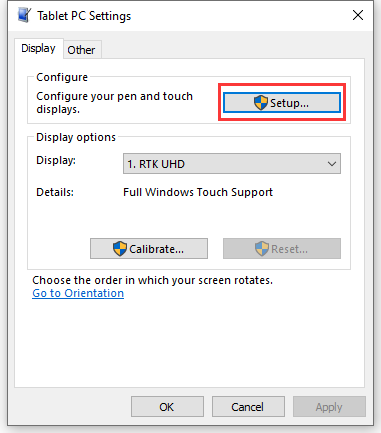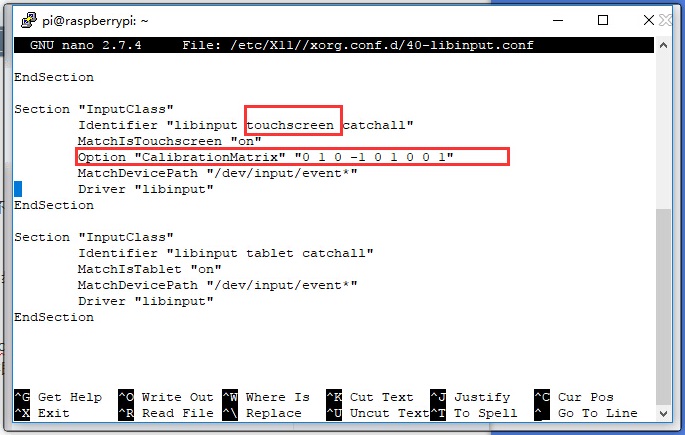7.9inch HDMI LCD
| ||
Introduction
This product is a general-purpose 7.9-inch HDMI display with a resolution of 400 × 1280 and a capacitive touch panel, which supports Raspberry Pi and can also be used as a computer monitor.
| More |
Features
- 7.9-inch IPS screen, 400 x 1280 resolution, HDMI/USB interfaces.
- 5-point capacitive touch control, tempered glass panel, hardness up to 6H.
- Working with Raspberry Pi, it supports Raspberry Pi OS/Ubuntu/Kali and Retropie, single touch and driver free.
- Working as a computer monitor, it supports Windows 11/10/8.1/8/7, five-point touch, and driver free.
- HDMI audio input 3.5mm headphone/speaker jack.
EDID Timing Parameters
If the system of the main control board can automatically recognize the EDID for display, there is no need to set the relevant timing parameters additionally.
Otherwise, you can refer to the following EDID settings:
| Pixel Clock | H Adressable | H Blanking | V Adressable | V Blanking | H Front Porch | H Sync Width | V Front Porch | V Sync Width | H Image Size | V Image Size | H Border | V Border |
|---|---|---|---|---|---|---|---|---|---|---|---|---|
| 43.00 | 400 | 140 | 1280 | 42 | 70 | 10 | 20 | 10 | 60 | 191 | 0 | 0 |
Working with PC
This LCD supports Windows 7/8/8.1/10/11 when working with a PC via HDMI interface.:
1. Connect the TOUCH interface of the LCD to the USB interface of the PC. Waiting for a moment, The touch will be recognized by Windows automatically.
2. Connect the HDMI interface of the LCD to the HDMI port of the PC. About 10s later, you can see that the LCD display properly. If you need to output sound, you can connect to 3.5mm headphones through HP audio output port.
Note:
1) When the computer is connected to multiple monitors at the same time, the touch effect of the 7-inch LCD will be applied to the main screen by default. If you need to specify the touch to the secondary screen, see #Calibration touch on Win 10 PC
2)Sometimes LCD will flicker because of undersupplying from the USB cable of the PC. You need to connect an external power supply (5V/2A) to the DC port.
Calibration touch on Win 10 PC
Take the windows10 system as an example:
- 1. Enter the Windows settings of the system, type in the search bar and click "Calibrate the screen for pen or touch input" (as shown in the picture below).
- 2. Click "Setup" in the pop-up "Tablet PC Settings" interface:
- 3. The following text prompt will appear on the screen. Please tap the touch screen with your finger, and the computer will recognize it as a touch screen.
【Note】If the touch screen is blank, press the "Enter" key, and the text prompt will switch to the touch screen. (The screen which displays the text prompt will be used as a touch screen!)
Working with Raspberry Pi
This LCD can support Raspberry Pi OS/Ubuntu/Kali/Retropie systems.
Please download the latest version of the image on the Raspberry Pi official website.
- 1) Download the compressed file to the PC, and unzip it to get the .img file.
- 2) Connect the TF card to the PC, and use SDFormatter software to format the TF card.
- 3) Open the Win32DiskImager software, select the system image downloaded in step 1, and click 'Write' to write the system image.
- 4) After the image has finished writing, open the config.txt file in the root directory of the TF card, add the following code at the end of config.txt, then save and quit the TF card safely.
hdmi_group=2 hdmi_mode=87 hdmi_timings=400 0 100 10 140 1280 10 20 20 2 0 0 0 60 0 43000000 3
- 5) Insert the TF card into the Raspberry Pi
- 6) Connect the Touch interface of the LCD to the USB port of Raspberry Pi.
- 7) Connect the HDMI interface of the LCD to the HDMI port of the Raspberry Pi and then power on the Raspberry Pi, it can display normally after waiting for about a few seconds.
Note:
- The screen is displayed vertically by default. For convenience, you can adjust the display orientation of the screen, see #Rotation(Working with Raspberry Pi).
- When the Raspberry Pi is connected to multiple monitors at the same time, the touch effect of the 7-inch LCD will be applied to the main screen by default. If you need to specify the touch to the secondary screen, see #Calibrate double-touchscreen in Pi 4
Rotation (Working with Raspberry Pi)
- Display Orientation
To change the orientation, you can add the following line to the config.txt file and reboot.
display_rotate=X
- X can be 1: 90°; 2: 180°C; 3: 270°
For example, if you want to rotate it 90 degrees, you can add the line display_rotate=1
Note: If it is Raspberry Pi 4, also need to comment out dtoverlay=vc4-fkms-V3D.
And then restart the Raspberry Pi after saving.
sudo reboot
- Touch orientation
After the display is rotated, the position of the touch is incorrect because the touch doesn't change with the display angle. So the touch also needs to be modified.
For this display, we provide two touch rotation methods.
Rotation by modifying the software
1. Install libinput.
sudo apt-get install xserver-xorg-input-libinput
2. Create the xorg.conf.d directory under /etc/X11/ (if the directory already exists, proceed directly to step 3).
sudo mkdir /etc/X11/xorg.conf.d
3. Copy the 40-libinput-conf file to the directory you created just now.
sudo cp /usr/share/X11/xorg.conf.d/40-libinput.conf /etc/X11/xorg.conf.d/
4. Edit this file.
sudo nano /etc/X11/xorg.conf.d/40-libinput.conf
Find the part of the touchscreen, add the following statement inside, and then save the file.
Option "CalibrationMatrix" "0 1 0 -1 0 1 0 0 1"
Similar to the picture below:
5. Restart the Raspberry Pi.
sudo reboot
Note:
90-degree rotation: Option "CalibrationMatrix" "0 1 0 -1 0 1 0 0 1"
180-degree rotation: Option "CalibrationMatrix" "-1 0 1 0 -1 1 0 0 1"
270-degree rotation: Option "CalibrationMatrix" "0 -1 1 1 0 0 0 0 1"
Rotate by button
In some special systems, when you cannot rotate by modifying the software, you can press and hold the "Rotate Touch" button for 5 seconds to rotate the touch. And you may need to test multitimes for the correct orientation.
We recommend using the software modification method. Otherwise, when using the new system, it may cause touch reverse errors. At that time, you need to press and hold "Rotate Touch" to rotate.
Calibrate double-touchscreen in Pi 4
- 1. Open the terminal and input the command: xrandr to check HDMI-ID of the main monitor. (It is HDMI-1 most time);
- 2. Input the command xinput in the terminal, and check the touch ID of the main monitor. (There should be two IDs, you can touch displays to check which is the main one);
- 3. Tun the command:xinput map-to-output <touch ID> <HDMI-ID>
(Don't forget to change the ID to the correct one just like: xinput map-to-output 7 HDMI-1)
- 4. You can set the command to auto-run while booting and make it affect all the time:
sudo nano /etc/xdg/lxsession/LXDE-pi/autostart
Add the line to the file: xinput map-to-output 7 HDMI-1 (Don't forget to change the ID to the correct one), then reboot.
Disable power saving
Open lightdm.conf.
sudo nano /etc/lightdm/lightdm.conf
Modify lightdm.conf to find the 'xserver-command' under the [SeatDefaults] section, uncomment it, and modify it as follows:
#xserver-command=X
Change into:
xserver-command=X -s 0 -dpms
- -s # – set screen saver not enabled.
- dpms turn off power saving management.
Restart:
sudo reboot
Backlight Control
You can control the backlight brightness by long pressing ON/OFF on the back of the LCD.
Note: If you increase the brightness, it may cause insufficient power of the LCD by getting power through the USB interface. To solve this problem, you can input 5V/2A power through the Power interface on the back of the LCD.
Resources
Software
Drawing
FAQ
Touchpad + LCD Thickness: 7.8mm.
Touchpad + LCD thickness + PCB board (without components): 9.8mm.
Touchpad + LCD thickness + PCB board (including HDMI port): 16.5mm.
It's M2.5.
For the old version:
As shown below, you can remove the original soldered resistor (the red one), and connect the green solder pad (as shown below) to the P1 pin of the Raspberry Pi.

For the new version:
As shown below, you can remove the original soldered resistor (the red one), and connect the yellow solder pad (as shown below) to the P1 pin of the Raspberry Pi.

The 5 levels are 300cd/m², 365cd/m, 420cd/m², 475cd/m², 530cd/m², and the current consumption range is 470~640mA.
Anti-Piracy
Since the first-generation Raspberry Pi released, Waveshare has been working on designing, developing, and producing various fantastic touch LCDs for the Pi. Unfortunately, there are quite a few pirated/knock-off products in the market. They're usually some poor copies of our early hardware revisions, and comes with none support service.
To avoid becoming a victim of pirated products, please pay attention to the following features when purchasing:
Beware of knock-offs
Please note that we've found some poor copies of this item in the market. They are usually made of inferior materials and shipped without any testing.
You might be wondering if the one you're watching or you've purchased in other non-official stores is original, feel free to contact us.
Support
Technical Support
If you need technical support or have any feedback/review, please click the Submit Now button to submit a ticket, Our support team will check and reply to you within 1 to 2 working days. Please be patient as we make every effort to help you to resolve the issue.
Working Time: 9 AM - 6 PM GMT+8 (Monday to Friday)








